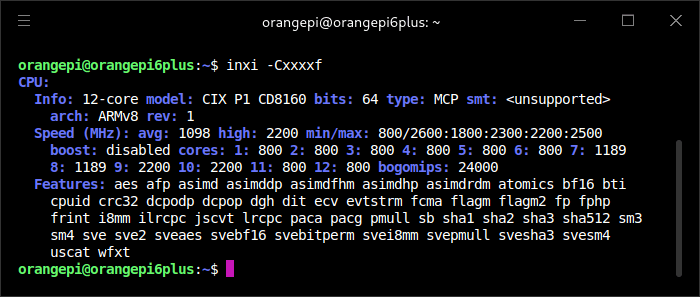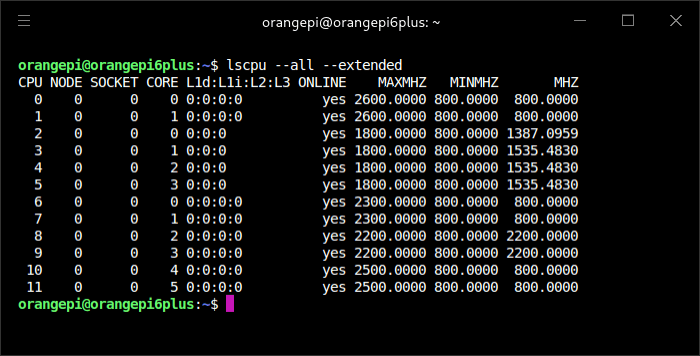I’ll use inxi, a system profiler, as well as a couple of other command-line utilities to look at the board’s specifications in detail.
CPU
The board has the CIX CD8180/CD8160 SoC. It has a built-in 12-core 64-bit processor. Not shown in the images below is the fact there’s also a NPU processor (which is rated at 28.8 TOPS).

We have a quad-core Cortex-A720 large core, quad-core Cortex-A720 medium core, and quad-core Cortex-A520 small core.
We can use lscpu to drill down a bit further. As you can see, the large core (the first two cores listed below) have a maximum clock frequency of 2600 MHz, the next four 1800 MHz, the next two 2300 MHz, the next two 2200 MHz, and the final two cores have a maximum clock frequency of 2500 MHz.

All the cores have a minimum 800 MHz clock frequency.
I will run a series of benchmarks in a later article in this series including on the individual cores. But for now, I’ll note the CIX CD8180 has a CPU Mark of 9277 which is almost double that of an Intel N100 processor.
The combined computing power is 45 TOPS (CPU, GPU and NPU combined).
Graphics

This is another area where the Orange Pi 6 excels. It has an integrated Arm Immortals G270 MC10 GPU which supports hardware ray tracing, OpenGL ES3.2, OpenCL 3.0, and Vulkan 1.3. There’s a great range of outputs available including HDMI (up to 4K 60 Hz refresh rate), DisplayPort (up to 4K 120 Hz refresh rate), two USB-C/DP ports (up to 4K 60 Hz refresh rate) as well as an eDP display port (up to 4K 60 Hz refresh rate)
There’s decent multimedia support too with:
Video decoding supported: AV1/H.265/H.264/VP9/VP8/H.263/MPEG-4/MPEG-2 formats
Video encoding supported: H.265/H.264/VP9/VP8 formats
Disk

When taking this image, I booted from a microSD card. I’ve also booted the system from a fast USB 3.2 Gen1 Type-C USB drive, as well as having both the microSD and USB drives connected. Debian automatically mounts both.
There are also 2 NVMe SSD M.2 M-Key 2280 slots available which offer even better performance. You can boot the board from either NVMe.
Memory

inxi’s output is correct. If you look closely at the reference images (final page of this article) you’ll see there are four RAM chips.
Besides the 32GB of RAM model I’m testing, you can get the Pi 6 Plus with 16GB or 64GB of RAM. That’s a fair chunk of RAM for a single-board computer.
Network

The board has two 5G ethernet ports (which support 1G, 2.5G and 5G). My home network is only running 2.5G.
I’ve also got a WiFi 2230 Wi-Fi6/BT module attached (this needs to be purchased separately).
Audio

There’s a 3.5mm headphone jack audio input/output. There’s also a MIC audio input interface and 2 speaker audio output interface.
Temperature
This reading from the sensors utility was taken with the board at idle.

There are other ports on the machine including USB 3.0 and USB 2.0, 2 x MIPI CSI 4 Lane interface camera., RTC battery interface, 10-pin debug serial port, and more. Take a look at the reference images on the next page.
Next page: Page 4 – Reference images
Pages in this article:
Page 1 – Introduction
Page 2 – First steps
Page 3 – Interrogation of the system
Page 4 – Reference images
